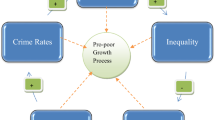Abstract
This paper analyzes the impact of TELs on different types of state expenditures. This study provides comparison analysis of different types of TELs on state level and aims to evaluate the effect of TEL policy on state expenditure structures. Using panel data analysis, this work finds that states with Tax Expenditure Limitations (TELs) - in addition to financial factors- are associated with higher level of state expenditures for corrections and lower levels of state expenditures for police, parks, natural resources, and highway expenditures. Looking at 50 states from 2006 to 2011, this relationship is both statistically and substantively significant.
Similar content being viewed by others
References
Archibald, R.B. & Feldman, D.H. 2004. State higher education spending and the tax revolt. College of William and Mary, Department of Economics, Working Paper Number 10. Retrieved from: http://economics.wm.edu/wp/cwm_wp10.pdf
Bennett, J., & DiLorenzo, T. (1982) The political economy of corporate welfare: industrial revenue bonds. CATO Journal, 2(2), 607–617.
Brennan, G., & Buchanan, J. M. (1978). Tax instruments as constraints on the disposition of public revenues. Journal of Public Economics, 9(3), 301–318. Elsevier.
Brome, H. & Saas, D.R. (2006). Reading the fine print: how details matter in tax and expenditure limitations. New England Public Policy Center Research Report 06–3, October 2006. Retrieved from: http://www.bostonfed.org/economic/neppc/researchreports/2006/rr0603.pdf
Ermasova, N., & Mikesell, J. (2016). Fiscal disparity and equalization in the Russian Federation. Post-Communist Economies, 28(1), 1–15.
Figlio, D. N. (1998). Short-term effects of a 1990s-era property tax limit: panel evidence on Oregon’s Measure 5. National Tax Journal, 51(1), 55–70.
Fischel, W. A. (1989). Did Serrano cause Proposition 13? National Tax Journal, 42(4), 465–473.
Hill, E., Sattler, M., Duritsky, J., O’Brien, K. & Robey, C. (2006). A review of tax expenditure limitations and their impact on state and local government in Ohio. Cleveland State University, Maxine Goodman Levin College of Urban Affairs. March, 2006. Revised May, 2006. Retrieved from: http://cua6.urban.csuohio.edu/publications/center/center_for_public_management/tel31806.pdf
James, F. J., & Wallis, A. (2004). Tax and spending limits in Colorado. Public budgeting & Finance, 24(4), 16–33.
Kousser, T., McCubbins, M. D., & Moule, E. (2008). For whom the TEL tolls: can state and Expenditure limits effectively reduce spending? State politics and policy, 8(4), 331–361.
Lav, I. & McNichol, E. (2010). Additional federal fiscal relief needed to help states address recession’s impact: without it, states’ steps to balance their budgets could cost economy 900, 000 jobs next year. Center on budget and policy priorities. Retrieved from: http://www.cbpp.org/research/additional-federal-fiscal-relief-needed-to-help-states-address-recessions-impact
Maher, C. S. & Deller, S. C. (2010). Measuring the impacts of TELs on municipal financial conditions. Paper prepared for: States as Facilitators or Obstructionists of Local Government Conference, Feb. 25–27, 2010. Florida State University. Retrieved from: http://collinsinstitute.fsu.edu/files/pdf/seminar-2010-02-25/FINAL%20PAPER-MAHER.pdf
Marlow, M. L., & Joulfaian, D. (1989). The determinants of off-budget activity of state and local governments. Public Choice, 63(2), 113–123.
Mitchell, M. (2010). TEL it like it is: Do state tax and expenditure limits actually limit spending? Working Paper, Mercatus Center at George Mason University. Retrieved from: http://mercatus.org/sites/default/files/publication/TEL%20It%20Like%20It%20Is.Mitchell.12.6.10.pdf. Accessed 17 May 2016.
Mitchell, D. T., Hughes, D. R., & Campbell, N. D. (2014). Are powerful majorities inefficient for parties and efficient taxpayers? an analysis of budget maximization in the United States. Public finance review, 42(1), 117–138.
Mullins, D. R. (2004). Tax and Expenditure Limitations and the Fiscal Response of Local Government: Asymmetric Intra-Local Fiscal Effects. Public budgeting & finance, 24, 111–147.
Mullins, D. R., & Joyce, P. (1996). Tax and Expenditure Limitations and State and Local Fiscal Structure: An Empirical Assessment. Public budgeting & finance., 16, 75–82.
Mullins, D. R., & Wallin, B. (2004). Tax and Expenditure Limitations: Introduction and Overview. Public budgeting & finance., 24, 2–15.
NASBO (National Association of State Budget Officers) (2012). State Expenditure Report, Examining Fiscal 2010–2012 State Spending. Retrieved from: http://www.nasbo.org/sites/default/files/State%20Expenditure%20Report%20%28Fiscal%202010-2012%29.pdf
Sears, D. O., & Citrin, J. (1982). Tax revolt: something for nothing in California. Cambridge, MA: Harvard University Press.
Staley, T. (2015). The effect of TELs on state revenue volatility: evidence from the American states. Public budgeting and finance, 35(1), 29–48.
Sun, R. (2014). Reevaluating the effects of tax and expenditure limitations: an instrumental variable approach. Public finance review., 42(1), 92–116.
Wildavsky, A. B. (1980). How to limit government spending. Berkely, CA: University of California Press.
Yilmaz, Y., Hoo, S., Nagowski, M., Rueben, K. & Tannenwald, R. (2006). Measuring fiscal disparities across U.S. states: a representative revenue system/representative expenditure system approach, fiscal year 2002. NEPPC Working Paper 06–02. A joint report to the Urban-Brookings Tax Policy Center. Retrieved from: http://www.bostonfed.org/economic/neppc/wp/2006/neppcwp0602.pdf
Author information
Authors and Affiliations
Corresponding author
Rights and permissions
About this article
Cite this article
Kulik, J.M., Ermasova, N. Tax Expenditure Limitations (TELs) and State Expenditure Structure in the USA. Public Organiz Rev 18, 53–69 (2018). https://doi.org/10.1007/s11115-016-0361-3
Published:
Issue Date:
DOI: https://doi.org/10.1007/s11115-016-0361-3




